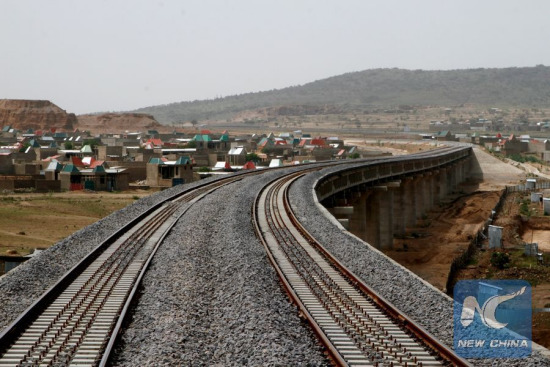
Photo taken on May 18, 2015 shows the Addis Ababa/Sebeta-DireDawa, Djibouti Railway project during the track laying completion ceremony of the project in Addis Ababa, capital of Ethiopia.(Xinhua/Michael Tewelde)
"We seek to build a perfect engineering as the goal," Yuan Li, chairman of China Civil Engineering Construction Corporation (CCECC), which is one of the two Chinese companies that built the Ethio-Djibouti railway project, told Xinhua in a recent interview.
Running a distance of 752.7 km, the Ethio-Djibouti railway project links the Ethiopian capital of Addis Ababa and Djibouti's Red Sea port city.
As Africa's first modern electrified railway, the project, an awe-inspiring work of the century, has been constructed by China Railway Engineering Co. and CCECC, which invested their innovative technology to achieve exceptional quality of the project.
Harar, a city with dominant Islamic architecture, is located on a hilltop in the eastern extension of the Ethiopian Highlands at an elevation of 1,885 meters.
In the year 2013, a group of Chinese were brave enough to expose themselves in the scorching sun light in Harar city and since then they have frequently visited there. They would go to the streets and sometimes stop to look around; they would sometimes be immersed in thinking or hold heated discussions.
These were Chinese railway technicians, who were looking for inspiration for a train station in the city of Dire Dawa, which has now been built along the Ethio-Djibouti railway line.
The station is shaped like a "gate," with shorter wings. The front of the waiting hall are tall arched doors in solemn and elegant Islamic architectural style.
The Chinese technicians had an inspiration of transforming the Dire Dawa station into a hub of fine art with artistic innovation. They aimed to incorporate Ethiopia's ancient architectural features into the station, and at the same time also reflect the vitality of the modern Ethiopia.
Every time they visit the place, the Chinese technicians would carefully improve and contemplate the station's design again and again. Having been revised for at least five times, the design of the Dire Dawa station has, finally, been highly acclaimed and welcomed by Ethiopian railway officials.
During the inauguration of the Ethio-Djibouti railway in Addis Ababa on Oct. 5, 2016, Ethiopian Prime Minister Hailemariam Desalegn, hailed the works of the Chinese railway company, and commended the Chinese government and people for the cooperation and support for the successful construction of the project.
"The Ethio-Djibouti railway fully demonstrates the technical capacity of Chinese companies," said the prime minister.
Not only serious about their artistically fine works, the Chinese workers have also carried out the project with great care to local community's concerns and high attention to environmental standards.
On Aug. 10, 2014, after receiving a telephone call from some local villagers who worried that their livestock could not cross the railway in flock, the project administrator immediately sent a task group to look into the situation.
Later, the railway construction personnel patiently explained to the villagers that they would design a 3 meter by 3.5 meter culverts, so that camels and other large animals can pass through. This solution received a positive response from the villagers.
There are two culverts per kilometer built by CCECC, with nearly 750 of them in total. Some of the culverts are large enough and become dedicated wildlife channels. Livestock and camels and other wild animals can cross freely.
Environmental protection is also an important issue linked to the project, and the Chinese companies have gone all out to build a green transport channel.
"As the ecological environment is fragile in Africa, pollution cannot be ignored, especially the mud," said a Chinese expert from the project department.
The large quantity of mud driven out by concrete can easily pollute water. If farmers reuse contaminated water for irrigation, crops will be damaged.
The Chinese team decided to discharge all the mud to a designated location, which is an excavated mud pool. When the construction is completed, the mud pool would be filled and restored to the original appearance.
In the construction of the project, not only mud was given due attention, even the soil cannot be arbitrarily carried out. When building roadbed, Chinese companies strictly used soil within a limited area, preventing pollution of the environment. They also paid a lot of attention to reclamation and greening restoration work.
During a ceremony held in Djibouti, the Ethiopian prime minister said the project would significantly boost development of the two countries and enhance their contribution to global market.
"This magnificent project will play an indispensable role in achieving our full-scale economic growth ... This railway line will improve the socio-economic landscape of the two countries," he said.


















































